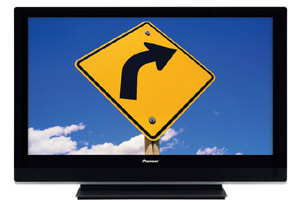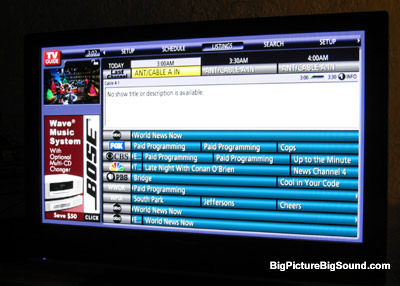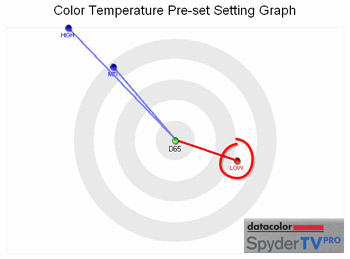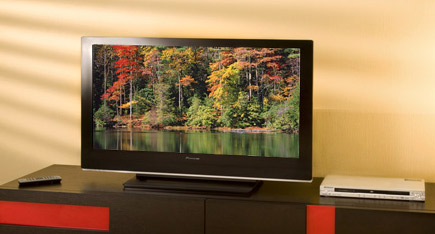Pioneer PDP-4270HD 42-inch Plasma HDTV Review
By Chris Boylan
Less is More
Buying a TV used to be easy. They were all one shape (roughly square), all one technology (good ole cathode ray tube), and all really heavy. You picked your favorite brand in the biggest screen size you could afford, handed over your credit card and hoped you wouldn't get a hernia lifting it into your entertainment center. Today's TV buyer doesn't have it quite so easy... except maybe for the heavy lifting part.
Buying a television today requires you to select from an alphabet soup of technologies and features: LCD, DLP, SXRD, LCOS, DILA, Plasma, HDTV, HD-Ready TV, ATSC, QAM... not to mention the different resolutions: 852x480, 1024X768, 1280X720, 720p, 1920X1080, 1080i, 1080p, etc. It's enough to drive a person nuts. We (particularly manly men), like to keep things simple: give me a number, or two, like a contrast ratio of 2,000:1 and a resolution of 720p and a brightness of 500 nits. If there are numbers, then we just have to pick the biggest numbers to get the biggest, baddest HDTV in the land, right? Unfortunately, No.

Pioneer PDP-4270HD - this way to great-looking, feature-packed HDTV.
You see, just as with digital cameras (with the ever-advancing war of the megapixels), the picture quality on a television is not always directly related to numeric specifications, not even important ones like screen resolution (an absolute measure of the number of pixels on the screen). Factors like perceived contrast, color saturation, panel response time, and video processing circuitry can contribute more toward a television's quality than just the raw pixel count.
What does this mean to you? This means that if you're out there looking only at numbers, and particularly only at resolution specs (e.g., 1080p vs. 720p), you may miss the "big picture" and buy a set with inferior picture quality simply because it has "better specs." Indeed you might pass over a real gem like the
Pioneer PDP-4270HD plasma HDTV under review here. Oops, am I giving away too much too early? Well read on to find out why numbers don't always tell the whole picture.
Numbers Never Lie... or Do They?
Don't get me wrong, objective numeric specifications are extremely useful. Given two sets made by the same manufacturer, using the same technology and the same video processing, the one with higher resolution (more pixels) will probably produce a clearer, more detailed, more pleasing picture. But when you compare TVs across technologies, e.g., LCD flat panel vs. plasma, vs. DLP projector vs. LCD projector, you may as well throw the numbers out the window due to fundamental differences in how these technologies produce a picture.
For example, an LCD or DLP projection television (front projection or rear projection) uses a very small computer chip with lots of pixels on it, combined with a high intensity lamp and high-power lens to project and magnify this tiny image onto a large screen. An LCD "flat panel" includes an array of LCD elements embedded into a screen that are illuminated from behind using one or more lamps so that they'll be bright enough to see from across the room.
A plasma panel (also called a PDP for "plasma display panel") also uses an array of individual pixels, but these are excited by electrical currents to produce specific colors at specific times in order to reproduce a moving image. Because these pixels are "internally illuminated" (i.e., they glow and require no external light source) plasma TVs can generally produce better perceived contrast ratios and deeper richer blacks and dark colors. They also tend to change "state" (on to off to on) quicker than LCD TVs can, which reduces annoying artifacts like motion blur and trails from fast-moving images. So, generally speaking, based on the current state of technology, plasma has some inherent advantages over LCD.
And Now Back to our Regularly Scheduled Review...
OK, that was a long way to go to set up a review, but a primer on technology is probably useful to those in the market for an HDTV right now. Even more details on specs and general set-up tips for any HDTV can be found in our "
How To Set Up your Fancy New HDTV" series of articles.

The PDP-4270's remote control offers direct input buttons for each source, but no backlighting.
Features and Ergonomics
The menus of the PDP-4270 are fairly straightforward. I was able to get the ATSC and NTSC tuners set-up and working pretty quickly. It did take over 15 minutes for the TV to "auto-tune" the SD and HD channels from a digital cable feed, but testing from an antenna feed completed the auto-setup in under 3 minutes.
Once the channels are set, the TV's on-board TV Guide On Screen feature asks you for cable provider details so it can properly identify your channel line-up. You can also select "off air" for broadcast TV channels if you are not using cable TV. The unit then downloads the TV Guide program listings overnight via your local TV host channel and continues to keep the guide updated via nightly automated downloads. Unlike Tivo, no phone jack or internet connection is required as the program data is downloaded right over the air or over the cable TV signal.
The remote control is highly functional but not exceptional. It does have direct input buttons for each input (which is great), but some of the commonly used buttons are small and not well offset from other similarly sized buttons. In day to day use, I became familiar with the button layout quickly and did not have to worry too much about hunting to find specific buttons. The TV is "smart" enough that when you are watching something on one of the external video inputs like HDMI or component, but hit the "Channel Up" button, it automatically switches over to the internal tuner and changes the channel. This makes it much quicker to select between inputs or switch sources.
I had thought that perhaps the TV would be heavier than the comparably-sized LCD units we've had on-hand lately (Vizio and Syntax-Brillian), but it was actually much lighter (63 pounds), even with the glass screen. The styling is simple but elegant, with a gloss black frame surrounding the anti-glare glass screen.
In terms of features, the PDP-4270 is about as feature-packed as you'll find in a television today. It offers 2 HDMI and 2 component video inputs, composite and s-video inputs as well as a VGA computer input. It also includes a USB port, to which you can connect a USB flash drive with pictures which can then be displayed directly on the plasma screen via its "home gallery" function. Outputs include standard RCA stereo output, monitor video output, a subwoofer output and a digital audio output so you can connect the TV's built-in tuner to your surround sound system for discrete 5.1-channel surround (when the content supports it, of course).
The set also includes built in digital and analog tuners - NTSC, ATSC and QAM - so it can tune in local channels via an antenna or cable connection. For premium cable channel access, the set includes CableCard support. If you'd like to watch all your cable channels without a box, then contact your cable provider for a CableCard for use with this television.

The TV Guide On-Screen program guide allows you to browse or search for your favorite programs.
The unit's integrated TV Guide On Screen function (mentioned earlier) allows you to see what's coming up on any of your channels for the next 8 days. You can even program the guide on the Pioneer to do timer recordings on an external VCR or DVD recorder via the included IR blaster. The PIP/split screen function works well but the remote button labels for PIP (at the bottom of the remote, below a lift-up panel) are not immediately obvious in location nor in their labels.
Viewing and Listening Impressions
Before calibration, the set exhibited some of the typical problems of digital flat panel technology including a faint grainy haze in light sections of the image and light motion smear, as well as excessive sharpness which led to more visible grain and slight ringing around the edges of images. After calibration these issues were ameliorated if not completely eliminated. We used
SpyderTV Pro to adjust color temperature, brightness, contrast, tint and color level, turned the sharpness control down to its lowest setting, and set MPEG noise reduction and PureCinema processing to "Low."
Unfortunately the Pioneer does not provide user access to individual red, green and blue gains and cuts (for precise color temperature setting). We were only able to select between "Low," "Mid," and "High" color temperature presets. The "Low" setting was the closest to NTSC standard 6500°. It did not get quite as close to NTSC standard as some of the LCD models we have tested lately (including the
Vizio and
Syntax Olevia units) but it was close enough to generate realistic looking colors, including believable flesh tones.

Without accessing the internal service menus, the "low" color temperature setting was as close as we could get to NTSC standard 6500° color temperature.
The Pioneer only reinforced my opinion that plasma technology is still the reigning champion of flat panels in all-important areas such as picture uniformity, color saturation and black level reproduction. LCD panel backlights tend to give the picture a slightly uneven look, particularly in darker scenes. The Pioneer plasma, with its self-illuminated pixels, does not suffer from this problem at all. HD-DVD movies, such as "Bourne Supremacy," and "Serenity" created sharp detailed images with reasonable image depth, and excellent color saturation.
To test the video processing, we subjected the set to a number of video torture tests including the HQV Benchmark DVD. The set performed extremely well in deinterlacing a 480i analog input from DVD, with virtually no "jaggies" on diagonal lines. 3:2 pulldown (detection of film-sourced material on DVD) also worked well though it was slightly slower than our reference HD-DVD player at identifying film-based content and adjusting its pulldown processing to compensate for it. The set did not perform as well reproducing "mixed" content (film sourced material with scrolling video titles superimposed on it). Fortunately this type of content does not turn up too often in the real world, except when you're watching a movie of film-based television program and a news alert or election results scroll across the bottom of the screen.
Using the set as a computer monitor (with a VGA cable) worked better than I expected. I was worried that the native 1024X768 resolution (and the TV's elongated pixel shape) might result in computer images being stretched, but you can select the screen shape you prefer, "Full" for the monitor to map the pixels one for one (which results in a "stretched" image) or "4:3" which preserves the standard computer monitor's 4:3 shape. In either mode, text came through readable and crisp and images and motion video were sharp and clear. In fact, I'm typing this review right now with the Pioneer as my monitor and the text is easily readable from across the room.
Inserting a flash drive into the USB port automatically brought up the "Home Gallery" feature, allowing me to browse through photos on the drive. You can view photos in their original resolution or full screen, but in full screen mode, images are stretched to fit the entire screen which will most likely distort the images unless their original shape happens to be 16:9.
Navigation back and forth through the images and rotation of the images is very straightforward via direct keys on the remote. But the lack of an automatic slide show function and the lack of an override to preserve the image's original aspect ratio in full screen mode limit its usefulness as a photo viewer. Consider it a bonus feature for casual image viewing.
The TV's built-in ATSC and QAM tuners worked well, picking up all of the local OTA and digital cable channels with excellent color saturation and minimal artifacts. Some digital tuners are a bit sluggish when changing channels but the Pioneer's tuner was pretty quick in this regard. High Definition live broadcasts such as "Late Night," "Saturday Night Live" and "The Tonight Show" were a pleasure to watch with deep blacks, vivid colors, and excellent detail in the clothing, background and in facial characteristics.

The PDP-4270's sleek gloss black styling will complement virtually any decor.
Although most TV speakers are not worth mentioning, the Pioneer's audio system was actually very listenable with several unique features. I tuned into the new music video channel "The Tube" which features an eclectic mix of music videos from the 70s to today. I experimented with the SRS Virtual Surround and TruBass features and found that both improved the sound without sounding overly processed or boomy.
There is also a "Focus" setting in the audio menu that, when set "on" enhances the midrange so that dialog is more intelligible. Very handy when watching a movie. Unlike most audio processing modes on televisions, all 3 of these settings improved the sound and I actually left all three features engaged for most listening sessions.
As always, we'd recommend using the set with a dedicated home theater system or high-end audio system. If you're going to spend over $2000 on the picture, you should spend at least that on the sound system. But, in a pinch, or for casual TV watching, the Pioneer's audio quality will definitely get you by.
Final Thoughts
Those who are shopping for an HDTV "by the numbers" may overlook the Pioneer PDP-4270HD, and that would be a shame. Its picture quality and feature set put it near the top of its class in the current crop of 42-inch HDTVs. At a list price of $2800, it's certainly on the higher end of the price spectrum, but as they say... you get what you pay for.
Where to Buy
•
Pioneer PDP-4270HD on Amazon.com
•
Pioneer PDP-4270HD on OneCall.com
Features and Specifications from the Manufacturer:
• Panel Size: 42 inches (diagonal)
• Panel resolution: 1024X768
• Aspect Ratio: 16:9
• Technology: Plasma Panel with deep-encased cell structure and crystal emissive layer
• Pure Color Filter
• Viewing Angle: Up to 160° horizontal and vertical
• Pure Drive II Signal Processing (10-bit)
• ACE IV (Advanced Continuous Emission) processing
• Advanced Pure Cinema™ processing
• Color Temperature Adjustment: 3 settings (high/mid/low)
• Digital Noise Reduction: 4 Settings (off/high/mid/low)
• MPEG Noise Reduction: 4 Settings (off/high/mid/low)
• Digital CTI: Color Transient Improver (on/off)
• Integrated Media Receiver with Dual NTSC and ATSC Tuner with CableCARD™ Interface
• Independent Dual HDMI® Inputs with the ability to accept a 1080p/24Hz signal
• TV Guide On Screen® Interactive Program Guide (TVGOS)
• A/V Selection Memory: 5 options for viewing preferences
• "Dot by Dot" for PC
• Split Screen/Picture in Picture modes
• Home Gallery allows photo viewing via USB connection
• V-Chip Parental Control
• Remote Control features glow in the dark keys, direct input selection and TVGOS controls
• Input resolutions supported: 480i, 480p, 720p, 1080i, 1080p
• 13 Watt Stereo Amplifier With TruBass® 2-Way Stereo Speakers
• SRS® WOW®/FOCUS™/TruBass Surround Sound Audio
• Dimensions: (W x H x D): 40-15/16 x 26-3/4 x 4-1/2 inches (with integrated speakers)
• Weight: 63.9 lbs.
• Table Top Stand: Included
• MSRP: $2800.00
Inputs:
• Independent Dual HDMI with Audio
• Component (1 side/2 rear with Audio)
• Composite [1 side/3 rear (1 rear with Audio)]
• S-Video [2 rear (1 rear with Audio)]
• Antenna A & B (coax F-connector)
• USB (Mass Storage Class) (side input)
• PC (VGA) input
Outputs:
• Optical Digital Audio
• Monitor Out: Composite/Audio LR
• Subwoofer out
What's In the Box:
• PDP-4270HD Plasma HDTV
• Remote Control
• AA Batteries (x 2)
• Power Cord
• User Manual
Manufacturer's Contact Information:
Pioneer Electronics
1925 E. Dominguez St.
Long Beach, CA 90810
Phone: (800) 421-1404
Web:
www.PioneerElectronics.com




